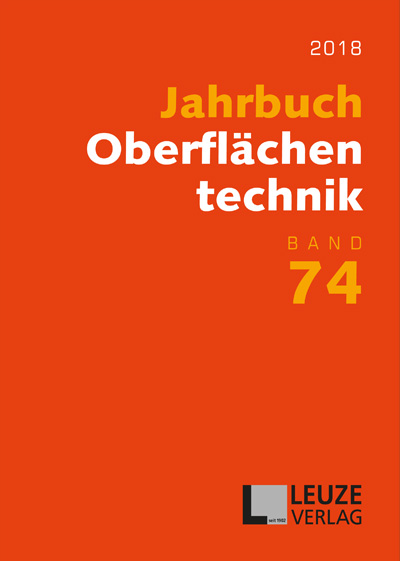

Jahrbuch Oberflächentechnik 2018, Band 74
Standard delivery time: 2-4 working days
Shipping costs
- There are no shipping costs for all individual item purchases or downloads.
- Book shipments within Germany are charged by weight (plus VAT):
Weight in kg
Cost in EUR
up to 0.5 kg
2.50
up to 1 kg
3.50
up to 3 kg
5.50
up to 31 kg
6.90
Book shipments abroad are charged according to weight and priority (plus VAT):
Weight in kg | Economy costs in EUR | Priority cost in EUR |
up to 0.5 kg | 5.00 | 6.00 |
up to 1 kg | 7.50 | 9.00 |
up to 2 kg | 13.00 | 16.00 |
up to 3 kg | 20.00 | 24.00 |
up to 4 kg | 26.00 | 31.00 |
up to 5 kg | 32.00 | 38.00 |
up to 5.5 kg | 37.00 | 44.00 |
up to 6 kg | 39.50 | 47.00 |
up to 7 kg | 45.00 | 54.00 |
up to 8 kg | 52.00 | 62.00 |
up to 9 kg | 58.00 | 69.00 |
up to 10 kg | 64.00 | 76.00 |
etc... |
Information
The 2018 Surface Technology Yearbook once again contains many valuable, cross-process articles on pre- and post-treatment as well as various coating processes, also with regard to forward-looking applications. One article, for example, is devoted to the mechanical chamfering of gear wheels for burr removal. It also examines pre-treatment in hot-dip galvanising and the activation of plastic surfaces using laser treatment to improve adhesive bonding. In the field of coating processes, one article examines the deposition of glass-like functional layers using a thin-film technology process, while another investigates the influence of PVD layers on the corrosion resistance of the substrate. In the field of electroplating, aluminium deposition for printed circuit board and microsystem technology is presented. In the field of post-treatment, there is an article on chromium(VI)-free colouring of high-alloy steel.
Although 3D printing is undergoing rapid development, which is also associated with a significant improvement in surface topography, surface technology still has great potential as a classic enabling technology. Wind energy continues to make an important contribution to a sustainable energy mix. High-performance turbines are particularly suitable for use in offshore areas, as there is little impact on people and nature. However, offshore use places immense demands and expectations on the performance and durability of the coatings used, not least because maintenance is extremely difficult. These issues are examined in detail in an essay. Micro-process engineering is another topic of the future in which surface technology plays an indispensable role. On the one hand, surface topography aspects in the diffusion welding of micro-process engineering components are discussed, and on the other hand, innovative micro-mirror arrays manufactured with the aid of surface technology in intelligent windows to increase building energy efficiency are presented.
In the field of process engineering, the yearbook contains an article on drying that is extremely helpful for all users. It also highlights the diverse applications of electroforming, from historical record production to Blueray and hologram applications.
The buzzword ‘Industry 4.0’ has been on everyone's lips for some time now. Many specialist events in the field of electroplating are also currently addressing this topic. On the one hand, it can be said that this is initially ‘only’ a further development of digitalisation and its extension to previously analogue processes. On the other hand, we are actually at a point where, thanks to the computing power that has been achieved and advances in machine learning, intelligent automation in the sense of self-learning production facilities seems possible beyond ‘normal’ networking. This naturally affects the electroplating industry as much as other manufacturing industries, and it can be assumed that the upheavals will be enormous in the short or long term, which of course also raises social questions.
This year, three essays deal with hardware and software issues relating to digitalisation, i.e. the focus is on expanding the degree of digitalisation in the various sub-production processes in electroplating. The possibilities of radio technology and the software-based mapping and networking of the various process steps are examined.
Target group:
Researchers, developers, process and quality engineers
Topics:
- Mechanical, physical and chemical pre-treatment
- Coating processes (electroplating, thin-film technology, thermal spraying)
- Post-treatment processes
- Coatings for 3D printing
- Coatings for offshore applications
- Surface technology aspects in microprocess engineering
- Industry 4.0 – points of contact for electroplating technology
- Overview articles on surface technology or transdisciplinary topics
A total of 19 articles. The company directory rounds off the 2018 Surface Technology Yearbook.
Information
Keywords:
No reviews yet. Be the first to review this product.

